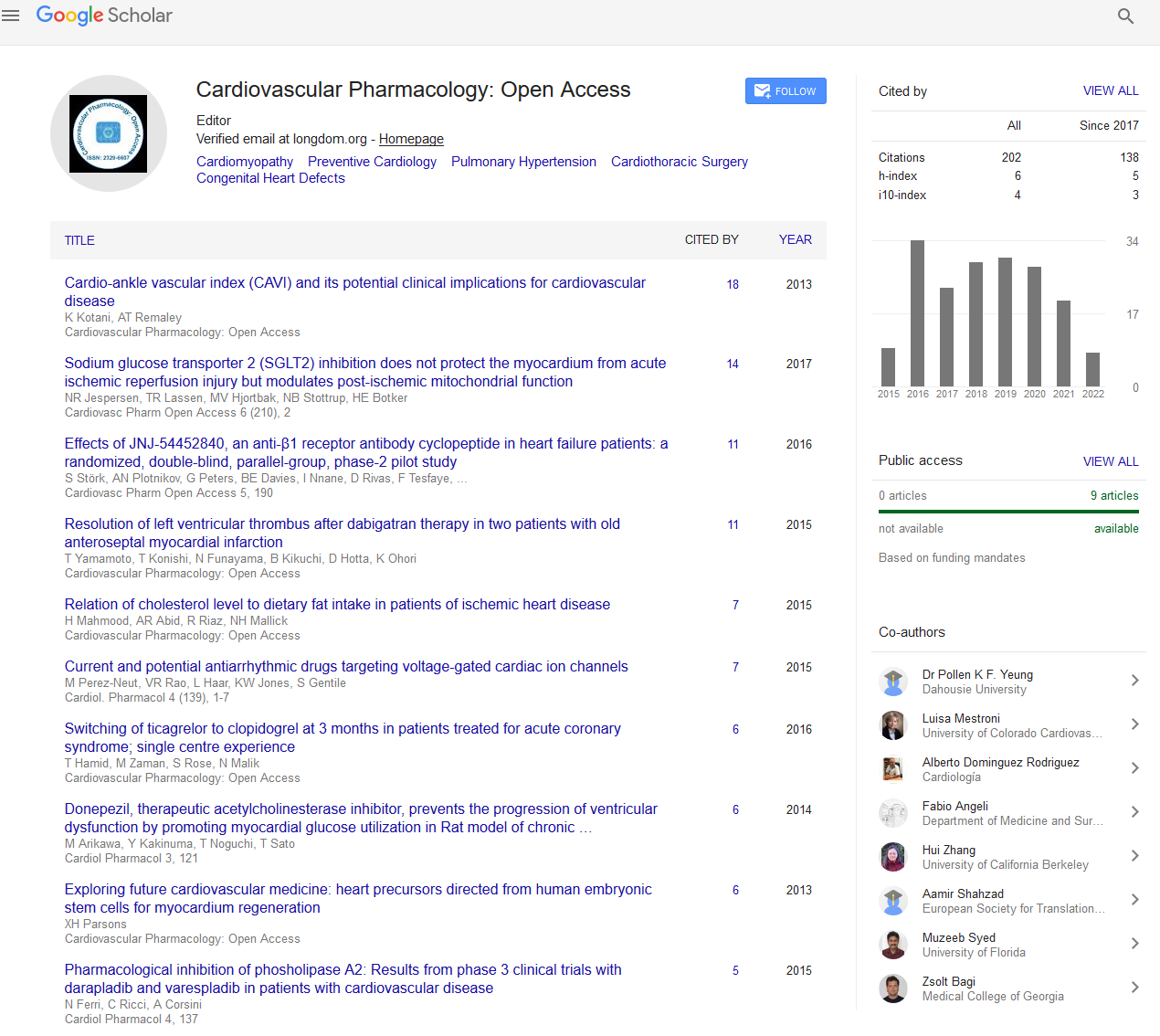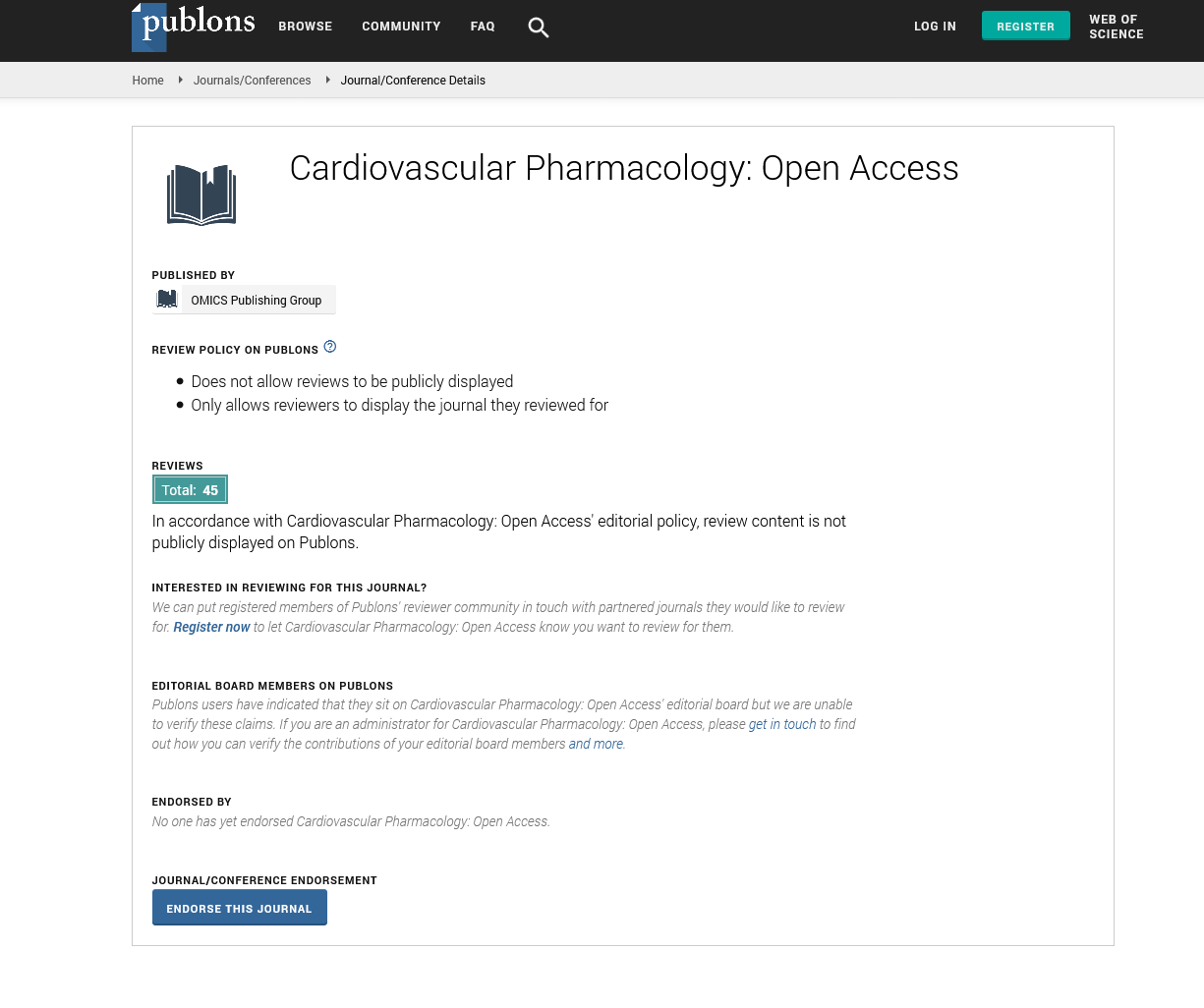Indexed In
- Open J Gate
- Cosmos IF
- RefSeek
- Hamdard University
- EBSCO A-Z
- OCLC- WorldCat
- Publons
- Geneva Foundation for Medical Education and Research
- Euro Pub
- Google Scholar
Useful Links
Share This Page
Journal Flyer

Open Access Journals
- Agri and Aquaculture
- Biochemistry
- Bioinformatics & Systems Biology
- Business & Management
- Chemistry
- Clinical Sciences
- Engineering
- Food & Nutrition
- General Science
- Genetics & Molecular Biology
- Immunology & Microbiology
- Medical Sciences
- Neuroscience & Psychology
- Nursing & Health Care
- Pharmaceutical Sciences
Perspective - (2025) Volume 14, Issue 2
The Role of Calcium Channel Blockers in Hypertension Management
Emily Johnson*Received: 29-May-2025 Editor assigned: 31-May-2025 Reviewed: 14-Jun-2025 Revised: 20-Jun-2025 Published: 28-Jun-2025
Description
Calcium Channel Blockers (CCBs) are among the most commonly prescribed medications for managing hypertension worldwide. Their primary mechanism involves blocking the influx of calcium ions into vascular smooth muscle cells and cardiac myocytes. By inhibiting calcium entry, these drugs cause relaxation of blood vessels, leading to decreased vascular resistance and reduced myocardial oxygen consumption. This pharmacological effect results in vasodilation and subsequently lowers blood pressure, which has played a critical role in decreasing the incidence of serious complications such as stroke, myocardial infarction and kidney damage associated with long-standing hypertension.
The discovery of calcium channel blockers dates back to the 1960s when scientists first recognized their ability to influence vascular tone by modulating calcium ion flow. Since that time, these drugs have been divided into two main categories: dihydropyridines and non-dihydropyridines. Dihydropyridines examples include amlodipine and nifedipine primarily target vascular smooth muscle, resulting in potent vasodilation. Conversely, non-dihydropyridines such as verapamil and diltiazem exert effects not only on blood vessels but also on the heart’s conduction system, making them valuable in treating cardiac arrhythmias. The differences in their chemical structures contribute to variations in absorption, distribution, metabolism and elimination, which are key factors in selecting the appropriate agent for individual patients.
Choosing the right calcium channel blocker requires careful consideration of the patient’s overall health profile and coexisting medical conditions. For example, in elderly patients with isolated systolic hypertension a common presentation in this age group dihydropyridines have demonstrated superior blood pressure-lowering effects. On the other hand, individuals who suffer from arrhythmias or angina may gain more benefit from non-dihydropyridines due to their ability to modulate heart rate and cardiac contractility. Therefore, aligning the pharmacodynamics properties of the drug with the clinical scenario is essential to maximize therapeutic outcomes.
Over decades of clinical research, numerous trials have consistently validated the efficacy of calcium channel blockers in reducing cardiovascular events. Large-scale studies have shown that these medications can decrease the risk of stroke by as much as 40 percent compared to placebo. Additionally, calcium channel blockers have a favorable metabolic profile, making them suitable for patients with diabetes because they do not significantly impact glucose metabolism. Their neutral effect on lipid levels further enhances their suitability for long-term hypertension management, especially in patients with metabolic syndrome or dyslipidemia.
Despite these advantages, calcium channel blockers are associated with certain side effects. Dihydropyridines frequently cause peripheral edema, flushing and headaches, symptoms often linked to their potent vasodilator action. Non-dihydropyridines, meanwhile, may induce bradycardia or atrioventricular block, especially when combined with beta-blockers or other agents that depress cardiac conduction. Hence, careful monitoring is imperative, particularly in patients with preexisting conduction abnormalities or those on multiple cardiovascular drugs.
Beyond their traditional uses, Calcium Channel Blockers (CCBs) continue to demonstrate potential in emerging areas of cardiovascular and systemic disease management. For instance, their vasodilator effects make them valuable in treating certain forms of microvascular dysfunction, where impaired blood flow through small vessels contributes to tissue ischemia and pain. This is particularly relevant in conditions like migraine prophylaxis, where some CCBs have shown benefit in reducing the frequency and severity of attacks by modulating cerebral blood flow.
Moreover, ongoing research is exploring the role of calcium channel blockers in neuroprotection and cognitive health. Since calcium signaling is crucial in neuronal function, dysregulation can lead to neurodegenerative changes. Preliminary studies suggest that CCBs may have a protective effect against conditions such as vascular dementia, possibly by improving cerebral perfusion and reducing oxidative stress. Although these applications are still under investigation, they open new avenues for the repositioning of these drugs beyond cardiovascular care.
From a pharmacoeconomic perspective, calcium channel blockers offer a cost-effective option for hypertension management, especially in resource-limited settings. Their generic availability and relatively low cost enhance accessibility, which is critical given the global rise in hypertension prevalence. Furthermore, combination therapies that include CCBs paired with other antihypertensive like ACE inhibitors or diuretics have been developed to improve blood pressure control through complementary mechanisms, often allowing for lower doses and fewer side effects.
Patient adherence remains a central focus in improving treatment outcomes. Simplified dosing regimens, including once-daily extended-release formulations, reduce pill burden and enhance compliance, which is essential in chronic conditions like hypertension. Educational efforts to increase awareness about the importance of consistent medication use further support these pharmacological advances. In summary, calcium channel blockers continue to evolve in their clinical applications, with expanding therapeutic roles and improved delivery systems that address patient needs. Their versatility, effectiveness and affordability ensure that they will remain pivotal in cardiovascular pharmacology and beyond, contributing substantially to the global effort to combat hypertension and its complications.
Citation: Johnson E (2025) The Role of Calcium Channel Blockers in Hypertension Management
Copyright: © 2025 Johnson E. This is an open access article distributed under the terms of the Creative Commons Attribution License, which permits unrestricted use, distribution AND reproduction in any medium, provided the original author and source are credited.


